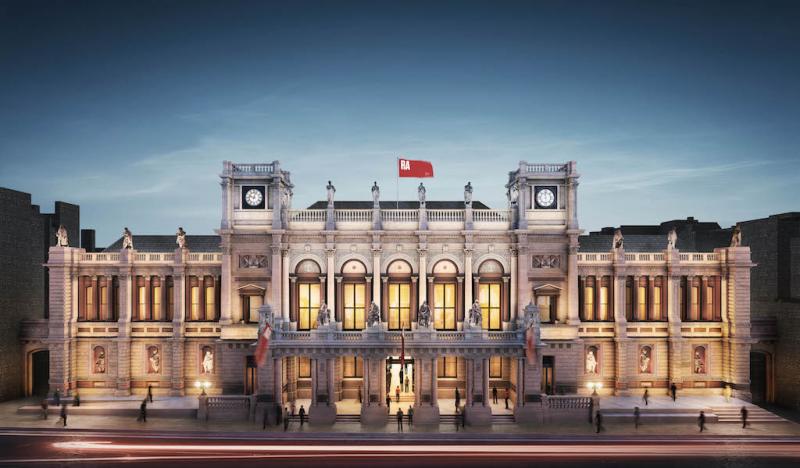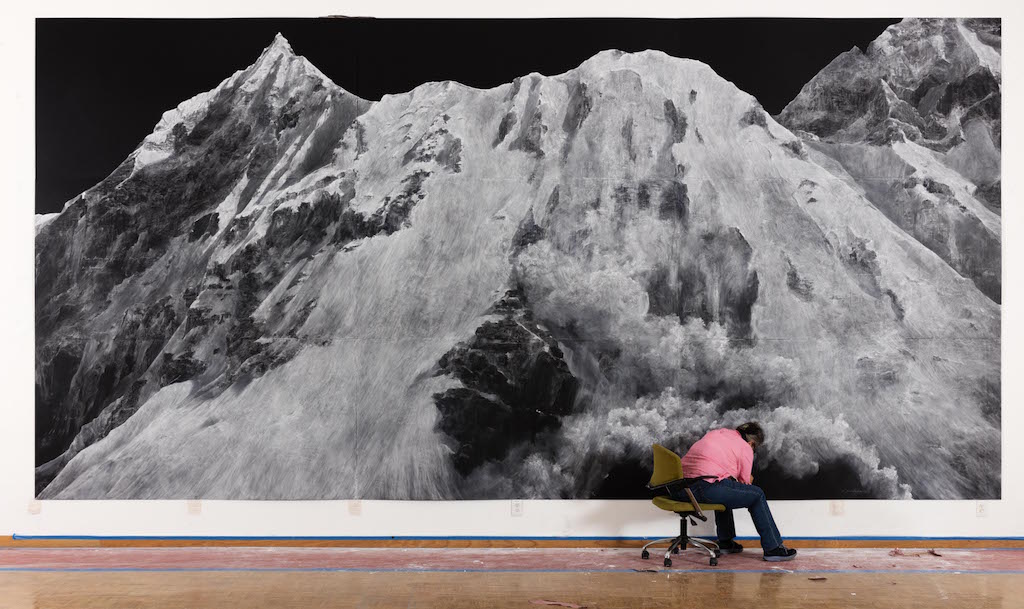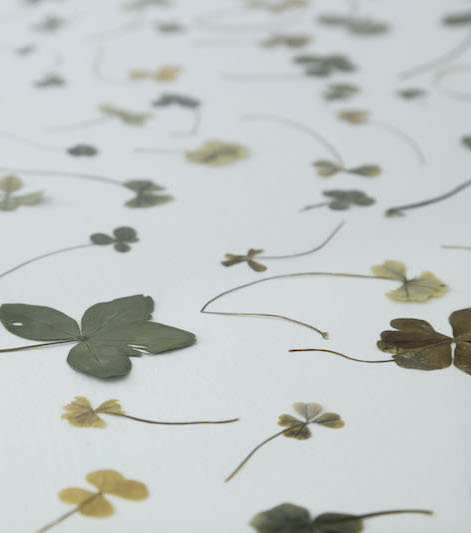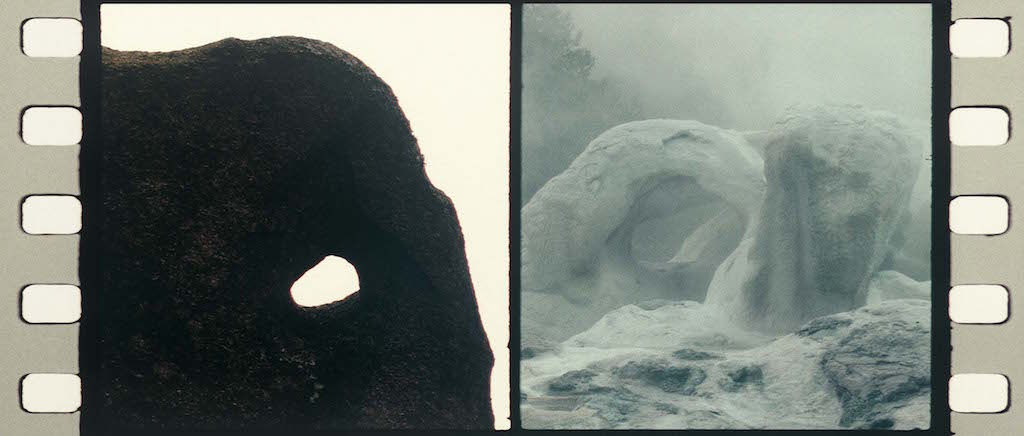The New Royal Academy and Tacita Dean, Landscape review - a brave beginning to a new era | reviews, news & interviews
The New Royal Academy and Tacita Dean, Landscape review - a brave beginning to a new era
The New Royal Academy and Tacita Dean, Landscape review - a brave beginning to a new era
From an institution known for excellent exhibitions to a hub of learning and debate

This weekend the Royal Academy (R.A) celebrates its 250th anniversary with the opening of 6 Burlington Gardens (main picture), duly refurbished for the occasion. When it was dirty the Palladian facade felt coldly overbearing, but cleaning it has highlighted the bands of sandstone and brown marble columns that lend warmth to the Portland stone.
The R.A bought the building in 2001. It is separated from Burlington House by only a few feet and is perfectly aligned with it, yet linking the two buildings has proved difficult. David Chipperfield’s solution comprises a vaulted corridor lined with plaster casts and the flayed figures once used to study anatomy. This cuts through the art school (I wonder how they will stop curious visitors wandering round the school?) and leads to a new bridge connecting the two buildings (pictured below right by Simon Menges).
 The most disappointing aspect of the refurbishment is the sacrifice of the spacious galleries at the north east corner of Burlington Gardens for a lecture theatre. This indicates a shift in how the R.A wants to be perceived. Rather than an institution known for its excellent exhibition programme, they are rebranding themselves as “a hub of learning and debate” and calling their enlarged premises “a new campus”.
The most disappointing aspect of the refurbishment is the sacrifice of the spacious galleries at the north east corner of Burlington Gardens for a lecture theatre. This indicates a shift in how the R.A wants to be perceived. Rather than an institution known for its excellent exhibition programme, they are rebranding themselves as “a hub of learning and debate” and calling their enlarged premises “a new campus”.
The ambition is to attract visitors all year round with a programme of lectures and family workshops. Another draw is a gallery devoted to the R.A’s collection, which includes Michelangelo’s Taddei Tondo, Self-portraits by luminaries such as Thomas Lawrence, Joshua Reynolds and Thomas Gainsborough, Turner’s painting of Dolbadern Castle and a group of Constable’s wonderful cloud studies. Despite these delights, though, its a dispiriting experience dominated by copies – plaster casts of classical Greek and Roman sculptures and copies of Leonardo’s Last Supper and Raphael’s tapestry cartoons. These may be useful for reference, but ultimately they are as lifeless as painted corpses.
Another draw is the new café at the top of the imposing staircase, but the introduction of a long bar makes the ornate room seem even narrower and less welcoming. Hopefully, the tables will spill out onto the landing to breathe some life into a building that feels as if everything happens behind new, very heavy doors – more closed down than opened up.
Sadly, only one suite of galleries is now available for the temporary exhibitions that, hopefully, will attract people to the “new campus”. These are bravely occupied by Tacita Dean with Landscape, the final part of her magnificent trilogy of exhibitions also showing at the National and National Portrait Galleries.
 Devoted to blackboard drawings, the first room is dominated by a wall-sized image of snow-covered peaks that, in its scale and ambition, conjures the awe with which Victorian artists like John Martin approached the immensity of nature. Dean’s title, Montafan Letter, 2018 (pictured above: Tacita Dean working on Montafan Letter by Fredrik Nilsen Studio) refers to a letter describing an avalanche that buried a village in the Austrian Alps in 1689. A second avalanche buried the priest who was officiating at the funeral, but a third one miraculously uncovered him.
Devoted to blackboard drawings, the first room is dominated by a wall-sized image of snow-covered peaks that, in its scale and ambition, conjures the awe with which Victorian artists like John Martin approached the immensity of nature. Dean’s title, Montafan Letter, 2018 (pictured above: Tacita Dean working on Montafan Letter by Fredrik Nilsen Studio) refers to a letter describing an avalanche that buried a village in the Austrian Alps in 1689. A second avalanche buried the priest who was officiating at the funeral, but a third one miraculously uncovered him.
Martin’s apocalyptic painting The Great Day of His Wrath, 1853 shows the devastation of a city by an earthquake, but Dean’s mountain has an almost surreal, picture-postcard serenity. Close-up you can see the scratchy marks made by the chalk – evidence of the work involved in creating this huge drawing. At a distance, though, one is seduced by her ability to conjure the ethereal quality of the light reflected off ice and snow. This dichotemy between the labour-intensive process and the effortless beauty of the final image somehow echoes our relationship with nature. The abundance of sublime pictures of dangerous places makes them seem safe and familiar and blunts our respect for and fear of the natural world.
 To create her series of cloud drawings, Dean developed a way of blowing liquid chalk onto the slates once used in Victorian schoolrooms. Beneath her filmy evocations of billowing clouds are the ghostly traces of diagrams and incised graffiti. Hand written snippets of Shakespearean text, such as “I do remember now”, create further links between evanescent form and historical record. And, nearby, a collection of spherical stones suggests another, equally poetic relationship between nature and culture.
To create her series of cloud drawings, Dean developed a way of blowing liquid chalk onto the slates once used in Victorian schoolrooms. Beneath her filmy evocations of billowing clouds are the ghostly traces of diagrams and incised graffiti. Hand written snippets of Shakespearean text, such as “I do remember now”, create further links between evanescent form and historical record. And, nearby, a collection of spherical stones suggests another, equally poetic relationship between nature and culture.
In the next room is a captivating collection of clover leaves with up to 9 leaves (pictured left: detail). Reliance on luck is an essential aspect of Dean’s working method. She has devised a way of masking sections of film so that only a portion of it is exposed at a time. Rewinding the reel and filming again allows her to juxtapose subjects recorded on different occasions and in distant locations. But since the results are revealed only once the filming is over, its a risky business.
Antigone is a multi-screen epic, based on her sister’s name, that explores blindness – stumbling about in the dark – as a metaphor for the creative process. We follow Oedipus (Stephen Dillane) hobbling across a stony landscape having plucked out his eyes on discovering that he has killed his father and married his mother. His wanderings are juxtaposed with shots of gases belching from blow holes in Yellowstone National Park and shrouding the surrounding rocks in volcanic ash, as though somehow nature were echoing his tragedy (pictured below: still from Antigone 2018) .
 Classicist Anne Carson discusses aspects of the Greek myth, including the role of Oedipus’s daughter/sister, Antigone, but with sound and image overlaid in a complex and often inaudible web, these sections feel like research that has infiltrated the main picture. Images of a solar eclipse recorded in California create a clear structure, but the film still seems to lose its way in a mire of unanswered questions about blindness, darkness and disability.
Classicist Anne Carson discusses aspects of the Greek myth, including the role of Oedipus’s daughter/sister, Antigone, but with sound and image overlaid in a complex and often inaudible web, these sections feel like research that has infiltrated the main picture. Images of a solar eclipse recorded in California create a clear structure, but the film still seems to lose its way in a mire of unanswered questions about blindness, darkness and disability.
Inaugurating the new galleries with an exhibition that adopts radical approaches to the traditional subject of landscape is a good beginning. Lets hope the Royal Academy can sustain this level of promise and so attract the visitors to Burlington Gardens that it dreams of.
rating
Explore topics
Share this article
The future of Arts Journalism
You can stop theartsdesk.com closing!
We urgently need financing to survive. Our fundraising drive has thus far raised £49,000 but we need to reach £100,000 or we will be forced to close. Please contribute here: https://gofund.me/c3f6033d
And if you can forward this information to anyone who might assist, we’d be grateful.

Subscribe to theartsdesk.com
Thank you for continuing to read our work on theartsdesk.com. For unlimited access to every article in its entirety, including our archive of more than 15,000 pieces, we're asking for £5 per month or £40 per year. We feel it's a very good deal, and hope you do too.
To take a subscription now simply click here.
And if you're looking for that extra gift for a friend or family member, why not treat them to a theartsdesk.com gift subscription?
more Visual arts
 'We are bowled over!' Thank you for your messages of love and support
Much-appreciated words of commendation from readers and the cultural community
'We are bowled over!' Thank you for your messages of love and support
Much-appreciated words of commendation from readers and the cultural community
 Photo Oxford 2025 review - photography all over the town
At last, a UK festival that takes photography seriously
Photo Oxford 2025 review - photography all over the town
At last, a UK festival that takes photography seriously
![SEX MONEY RACE RELIGION [2016] by Gilbert and George. Installation shot of Gilbert & George 21ST CENTURY PICTURES Hayward Gallery](https://theartsdesk.com/sites/default/files/styles/thumbnail/public/mastimages/Gilbert%20%26%20George_%2021ST%20CENTURY%20PICTURES.%20SEX%20MONEY%20RACE%20RELIGION%20%5B2016%5D.%20Photo_%20Mark%20Blower.%20Courtesy%20of%20the%20Gilbert%20%26%20George%20and%20the%20Hayward%20Gallery._0.jpg?itok=7tVsLyR-) Gilbert & George, 21st Century Pictures, Hayward Gallery review - brash, bright and not so beautiful
The couple's coloured photomontages shout louder than ever, causing sensory overload
Gilbert & George, 21st Century Pictures, Hayward Gallery review - brash, bright and not so beautiful
The couple's coloured photomontages shout louder than ever, causing sensory overload
 Lee Miller, Tate Britain review - an extraordinary career that remains an enigma
Fashion photographer, artist or war reporter; will the real Lee Miller please step forward?
Lee Miller, Tate Britain review - an extraordinary career that remains an enigma
Fashion photographer, artist or war reporter; will the real Lee Miller please step forward?
 Kerry James Marshall: The Histories, Royal Academy review - a triumphant celebration of blackness
Room after room of glorious paintings
Kerry James Marshall: The Histories, Royal Academy review - a triumphant celebration of blackness
Room after room of glorious paintings
 Folkestone Triennial 2025 - landscape, seascape, art lovers' escape
Locally rooted festival brings home many but not all global concerns
Folkestone Triennial 2025 - landscape, seascape, art lovers' escape
Locally rooted festival brings home many but not all global concerns
 Sir Brian Clarke (1953-2025) - a personal tribute
Remembering an artist with a gift for the transcendent
Sir Brian Clarke (1953-2025) - a personal tribute
Remembering an artist with a gift for the transcendent
 Emily Kam Kngwarray, Tate Modern review - glimpses of another world
Pictures that are an affirmation of belonging
Emily Kam Kngwarray, Tate Modern review - glimpses of another world
Pictures that are an affirmation of belonging
 Kiefer / Van Gogh, Royal Academy review - a pairing of opposites
Small scale intensity meets large scale melodrama
Kiefer / Van Gogh, Royal Academy review - a pairing of opposites
Small scale intensity meets large scale melodrama
 Jenny Saville: The Anatomy of Painting, National Portrait Gallery review - a protégé losing her way
A brilliant painter in search of a worthwhile subject
Jenny Saville: The Anatomy of Painting, National Portrait Gallery review - a protégé losing her way
A brilliant painter in search of a worthwhile subject
 Abstract Erotic, Courtauld Gallery review - sculpture that is sensuous, funny and subversive
Testing the boundaries of good taste, and winning
Abstract Erotic, Courtauld Gallery review - sculpture that is sensuous, funny and subversive
Testing the boundaries of good taste, and winning
 Edward Burra, Tate Britain review - watercolour made mainstream
Social satire with a nasty bite
Edward Burra, Tate Britain review - watercolour made mainstream
Social satire with a nasty bite

Add comment